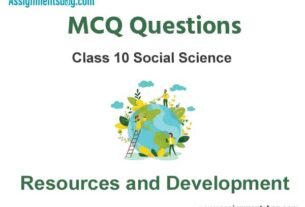Please refer to MCQ Questions Chapter 3 Water Resources Class 10 Social Science with answers provided below. These multiple-choice questions have been developed based on the latest NCERT book for class 10 Social Science issued for the current academic year. We have provided MCQ Questions for Class 10 Social Science for all chapters on our website. Students should learn the objective based questions for Chapter 3 Water Resources in Class 10 Social Science provided below to get more marks in exams.
Chapter 3 Water Resources MCQ Questions
Please refer to the following Chapter 3 Water Resources MCQ Questions Class 10 Social Science with solutions for all important topics in the chapter.
MCQ Questions Answers for Chapter 3 Water Resources Class 10 Social Science
Question. Which is the largest water resource project of India covering four states?
(a) Satluj Beas Dam
(b) Bhakra Nangal Dam
(c) Tehri Dam
(d) Sardar Sarovar Dam
Answer
D
Question. Which states the largest water resource project of India covers?
(a) Punjab, Haryana, Rajasthan and Gujarat
(b) Himachal Pradesh, Haryana, Jharkhand and UP
(c) Maharashtra, Madhya Pradesh, Gujarat and Rajasthan
(d) Assam, West Bengal, Sikkim and Arunachal Pradesh
Answer
C
Question. Irrigation has also changed the cropping pattern of many regions with farmers shifting to water intensive and commercial crops. This has great ecological consequences for the soil, what is it?
(a) Salinization of soil
(b) Contamination of soil
(c) Pollution of soil
(d) Excess of chemicals
Answer
A
Question. In spite of the fact that today plenty of water is available due to the perennial Indira Gandhi Canal in Rajasthan, why do many homes still prefer the Tanka System?
(a) Not enough to reach all homes.
(b) Water is not clean.
(c) Many do not like the taste of tap water.
(d) They feel more secure with the traditional system.
Answer
C
Question. Which state is the first state in India which has made rooftop rainwater harvesting structure compulsory to all the houses across the state?
(a) West Bengal
(b) Meghalaya
(c) Rajasthan
(d) Tamil Nadu
Answer
D
Question. In which place in Karnataka the people have installed, in their households’s rooftop, rainwater harvesting system to meet their water needs?
(a) Amachawadi in Mysore
(b) Gendathur in Mysore
(c) Chatnahalli in Mysore
(d) Gohali in Mysore
Answer
B
Question. In Rajasthan what is rainwater referred to as?
(a) Barsaat pani
(b) Baarish paani
(c) Palar pani
(d) Badal Pani
Answer
C
Question. Which among the following regions of India experience low rainfall and is drought prone?
(a) Rajasthan
(b) Gujarat
(c) Bihar
(d) Telangana
Answer
A
Question. How is rooftop rainwater filtered?
(a) Using sand and bricks
(b) Using electric filters
(c) Using net system
(d) Using modern filters
Answer
A
Question. Which of the following problems arises due to water pollution?
(a) Sedimentation of water bodies
(b) Water-borne diseases
(c) Discharge of industrial water
(d) Spawning of aquatic life
Answer
B
Question. Which of the following data shows the percentage of global precipitation that is received by India?
(a) 96.5%
(b) 30%
(c) 4%
(d) 2.5%
Answer
C
Question. Hirakud dam is constructed on the river-
(a) Ganga
(b) Manjira
(c) Manas
(d) Mahanadi
Answer
D
Question. How can we revolutionise agriculture?
(a) By building dams
(b) By releasing more water
(c) By making rainwater reserves
(d) Through developing drought resistant crops and dry farming techniques
Answer
D
Question. Which of the following is one of the largest artificial lakes of ancient India built in the 11th century?
(a) Govind sagar Lake
(b) Hauz-Khas
(c) Bhopal Lake
(d) Dal Lake
Answer
C
Question. Water is renewable resource because-
(a) it is being recycled by human beings.
(b) it is renewed and recharged through hydrological cycle.
(c) it is being renewed through reduction.
(d) it can be reused again.
Answer
B
Question. Which of the following hydraulic structures is built in river basins?
(a) Lakes
(b) Dams
(c) Tanks
(d) Water harvesting
Answer
B
Question. Why have multi-purpose projects and large dams have come under great scrutiny and opposition recently?
(a) The positioning of the dams is not technically correct.
(b) Regulating and damming of rivers affect their natural flow, causing poor sedimentation at the bottom of the reservoir.
(c) Chances of floods.
(d) Dams built recently are not strong enough.
Answer
B
Question. In which other places is rooftop rainwater harvesting common other than Rajasthan?
(a) Shillong
(b) Gujarat
(c) West Bengal
(d) Sikkim
Answer
A
Question. Which of the following areas would you immediately associate with water scarcity?
(a) Deserts of Rajasthan
(b) The Ganga plains
(c) Hills of North-eastern India
(d) Coastal areas of Odisha
Answer
A
Question. Multi-purpose projects and large dams have also been the cause of many new environmental movements like __________________.
(a) Narmada Bachao Andolan
(b) Save Satluj
(c) Save environment
(d) Green up to cool down
Answer
A
Question. In which of the following areas can you find one of the oldest water-harvesting systems of India?
(a) Sringaverapura near Allahabad
(b) Kalinga and Odisha
(c) Bennur and Karnataka
(d) Nagarjunakonda and Andhra Pradesh
Answer
A
Question. On which of the following rivers are the Tilaiya, Panchet, Maithon, Konar and Bokaro dams are located?
(a) Satluj
(b) Damodar
(c) Mahanadi
(d) Krishna
Answer
B
Question. Which of the following environmental damages are not induced due to multi-purpose projects?
(a) Water-borne diseases and pests
(b) Pollution resulting from excessive use of water
(c) Earthquakes
(d) Volcanic activity
Answer
A
Question. Which of the following dams are part of Chambal project?
(a) Maithon, Panchet, Tilaiya, Konar, Bokaro
(b) Pravara, Ramagundam
(c) Rana Pratap Sagar, Gandhi Sagar
(d) Sardar Sarovar Dam
Answer
D
Question. Which of the following is not a method of water harvesting used in Rajasthan?
(a) Johads
(b) Khadins
(c) Guls
(d) Tankas
Answer
C
Question. In which state is the 200-year-old system by using bamboo pipes still prevalent?
(a) West Bengal
(b) Rajasthan
(c) Meghalaya
(d) Shillong
Answer
C
Question. On which of the following rivers Tehri Dam is constructed?
(a) Bhagirathi
(b) Yamuna
(c) Kosi
(d) Sutlej
Answer
A
Question. Nagarjuna sagar Dam is built on which river?
(a) Chenab
(b) Mahanadi
(c) Krishna
(d) Satluj
Answer
C
Question. Which of the following contributes approximately 22 percent of the total electricity produced in India today?
(a) Solar power
(b) Hydroelectric power
(c) Geothermal energy
(d) Thermal power
Answer
B
Question. The release of water from dams during heavy rains aggravated the flood situation in Maharashtra and Gujarat in the year ________________.
(a) 2005
(b) 2004
(c) 2000
(d) 2006
Answer
D
Question. How did the multi-purpose projects affect the local people?
(a) Large scale displacement of local communities.
(b) They gained economically.
(c) The government gave them benefits.
(d) They got housing facilities.
Answer
A
Question. What is the rank of India in the world countries in the terms of water availability per person per annum?
(a) 129th
(b) 130th
(c) 131st
(d) 133rd
Answer
D
Question. Which among the following is not the dam based on structure and the material used?
(a) Timber dams
(b) Large dams
(c) Embankment dams
(d) Masonry dams
Answer
B
Question. The earth is occupied mostly with water yet freshwater resources are only
(a) 3.5%
(b) 5.5%
(c) 2.5%
(d) 0.5%
Answer
C
Question. The primary source of water is
(a) evaporation
(b) precipitation
(c) rain
(d) none of these
Answer
C
Question. Bhakra Nangal River Valley Project is made on the river-
(a) Sutlej-Beas
(b) Ravi-Chenab
(c) Ganga
(d) Son
Answer
A
Question. Which of the hydraulic structures is not a feature of ancient times?
(a) Multi-purpose river valley projects
(b) Dams built of stone rubble
(c) Reservoirs or lakes
(d) Embankments and canals
Answer
A
Question. Which of the following structures was constructed by Illtutmish in the 14th century for supplying water to Siri Fort area?
(a) Water harvesting at Sringaverapura near Allahabad
(b) Bhopal Lake
(c) Tank in Haus Khas
(d) Irrigation work at Nagarjunakonda
Answer
C
Question. We need more and more _________ for growing food.
(a) land
(b) water
(c) minerals
(d) none of these
Answer
B
Question. The water covered surface of the Earth is
(a) one-fourth
(b) three- fourth
(c) half of the earth
(d) none of these
Answer
B

We hope you liked the above provided MCQ Questions Chapter 3 Water Resources Class 10 Social Science with solutions. If you have any questions please ask us in the comments box below.


